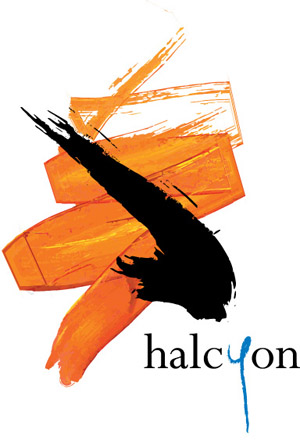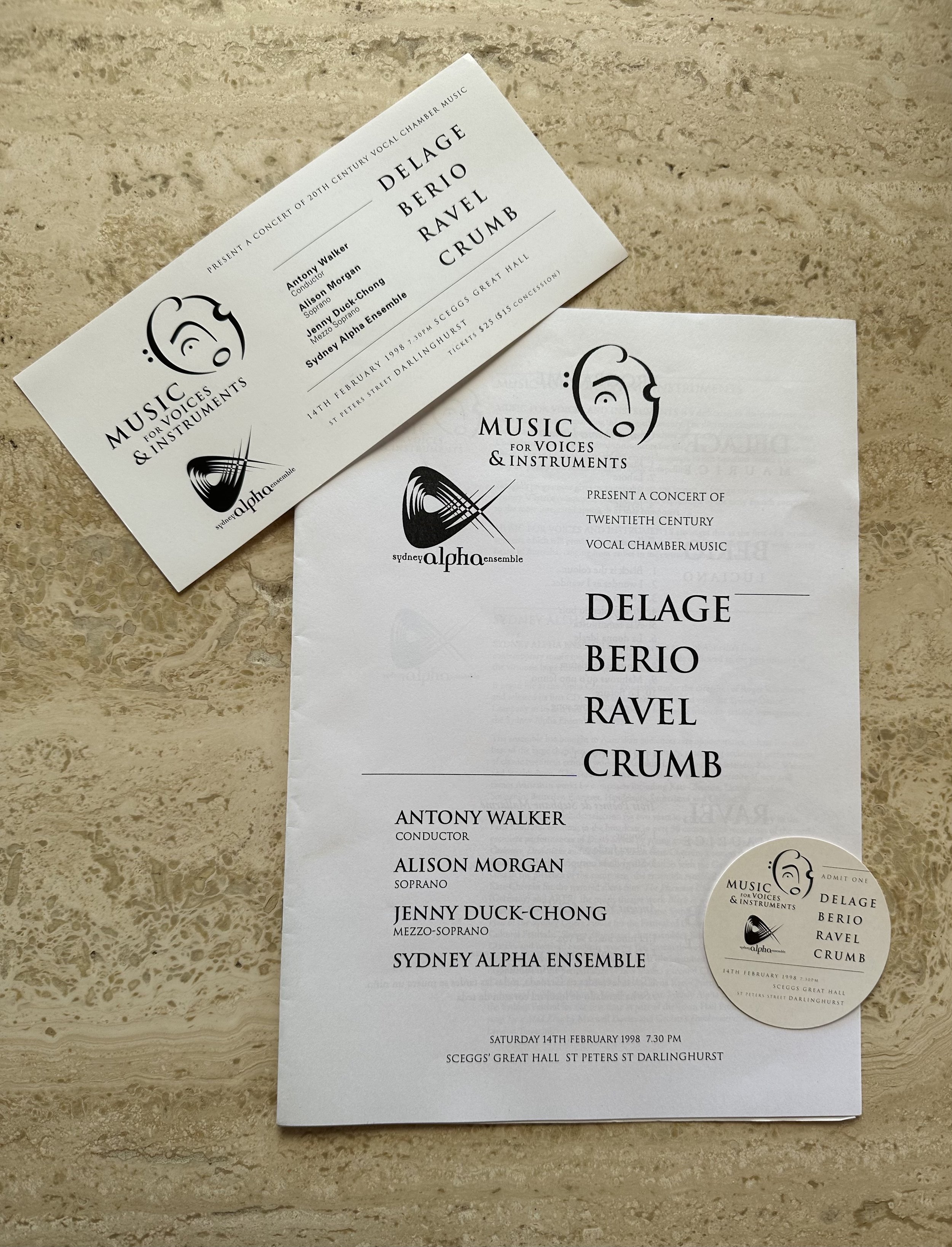On October 18, Halcyon is once again back in concert. As always, the program is a carefully curated mix of international and Australian works. It is a rare chance to hear the ensemble, now in its 26th year, performing small chamber works evoking the beauty of the natural world and the cycles of time and tide.
Night Tides is comprised of intimate trios and quartets drawn from an eclectic line up of eleven players - soprano, mezzo-soprano, flute, clarinet, violin, viola, cello, double bass, piano, percussion and harp.
For me this blog is a chance to write in long form about insights, connections and history and delve more deeply into the works and their creators. In Part 1, find out more about Gordon Kerry, Christine McCombe, Kevin March, Lisa Cheney. Click on their names or scroll down to discover more about them, their music and their work with Halcyon.
The Victorian composers
While state funding models encourage us to seek out local collaborators, I have always also sought to engage with musicians and composers across these borders as I think there is so much interesting work happening around the country. Night Tides features four Victorian composers: Gordon Kerry, Christine McCombe, Kevin March and Lisa Cheney.
Gordon Kerry
Three Malouf Songs (2015)
for mezzo-soprano, violin, cello and piano
Halcyon premiered this through-composed cycle in 2016 in The Poet's Voice, in the presence of the poet David Malouf, the composer and the work’s commissioners. John and Denise Elkins had wanted Gordon to write a piece to celebrate a place of signficance for them - the landscape around the Glasshouse Mountains in Queensland. The three interwoven poems describe the world reflected - a galaxy of stars seen in the wet sand at low tide, the water and its creatures in tidal rockpools and the looming Glasshouse Mountains in Deception Bay. I'm delighted to be returning to this beautiful and atmospheric cycle.
Reviewers after the first performance had this to say:
"Kerry created music that shimmered like water and brought out liquid motifs on the piano. Duck-Chong’s mezzo soprano beautifully amplified the glassy piano chords and string harmonies suggesting still and then suddenly shattered water surfaces. Malouf’s songs are intensely atmospheric."
Ben Apfelbaum, Sydney Arts Guide
Gordon Kerry’s Three Malouf Songs is a substantial new addition to the repertoire...This short cycle intrigues and I would like to hear it again as its numerous layers will keep on giving."
Alan Holley, Classikon
"still, blinking wonder in the poetry of David Malouf, set by Gordon Kerry"
Harriet Cunningham, Sydney Morning Herald
You can read full reviews here, here and here.
_______________________
Gordon's music has appeared in numerous Halcyon programs, with five works programmed across the years. You can read the list on The Music page here. He is also a featured composer in our In Conversation With... series.
If you’d like to hear more of his work you can listen to two other commissions, La Musique (Music) (2013) from the Kingfisher CD and My Sorrow’s Flower (2020) from our digital performance Holding Light in 2020.
Christine McCombe
Ebb Tide (2016)
for contralto, clarinet, cello and percussion
I read about the premiere of the song cycle Ebb Tide at an event called She Speaks: Voice of Home, a celebration of contemporary women composers, in Melbourne in 2017. I was drawn to the unusual instrumentation and keen to learn more about it. While the impetus for the creation of this work was the death of the poet (the work was commissioned by her brother), the work is not sombre. It’s six short individual movements are spare in their means, giving space for reflection.
In talking with the composer recently, she mentioned she had written about the process of creating this work in her chapter 'Finding Time, Finding Space' in the recent book The Composer, Herself: Contemporary Snapshots of the Creative Process. In it she has said:
"When I first read the poetry of Judith Cramond in 2015 I felt a strong connection to the creativity of another. Although Judith had died several years earlier, I had a powerful sense of her through her words and her use of imagery... Feeling a strong emotional and aesthetic connection to a text is important to me – there needs to be a compelling personal motivation for me to embark on the composition of a new piece. The work that emerged, ‘Ebb Tide’, was commissioned by the poet’s brother and the process of deciding which poems to set, what instrumentation to use, how long the work should be, was one of consultation and collaboration with the commissioner...
Elsewhere, the composer has commented: "I think music should aspire to create a space for contemplation. Every piece of music I write or work that I create strives for this in different ways but a common thread is the strangeness and beauty of human experience."
_______________________
Halcyon first performed Christine’s music in a very early Halcyon program, Earth Jewels, back in 2003; a piece for voice and guitar aptly called Halcyon, performed with guitarist Janet Agostino. I revisited these pieces in 2015 with guitarist Ken Murray in a program in Melbourne with the composer in the audience. After all those years, it was the first time we had met in person.
You can listen to more of her work here.
Kevin March
Two songs from Mythweaver (2010)
for soprano, flute, viola and harp
Halcyon’s then artistic directors met Kevin early in 2005 when he handed co-founder Alison Morgan and me a compilation CD of his music after Halcyon's first Melbourne performance (Sirens in Melbourne). He had recently relocated there and it was to be the beginning of many conversations and collaborative plans together.
Much in demand in recent years, since 2016 he has completed and had premiered numerous substantial vocal works - the operas Les Feulettes and Echo and Narcissus (2022 winner of the Green Room Award for New Opera) and several songs/song cycles. 2024 will see the premiere of two new works The Unknown Swimmer, written in collaboration with Judith Dodsworth and Electric Cathedral, a multi-media work for singers in a digital ‘environment’.
Mythweaver is a six-movement song cycle inspired by the poetry of Sappho. You can read more about it here. A few years ago I asked Kevin to arrange the first two songs from the cycle for me for an ensemble of voice, flute, viola and harp for a project that never came into being. With their moonlit poetry, the two songs Stars Around the Full Moon and The Moon Has Set seemed perfect for inclusion in this program and I am delighted to be joined by soprano Amy Moore (co-artistic director of The Song Company) for the premiere of the chamber version of these songs.
_______________________
Kevin composed Ophélie for Halcyon’s 2007 Shakespeare project, Lily on a Black Wave. (The piece later won the 2009 Dorian Le Gallienne Composition Award). His Sea blue bird features on Halcyon's Kingfisher CD. Kevin is also featured in the In Conversation With... series. You can listen to more of his work here.
Lisa Cheney
The Soul's Eternity from No Distant Place (2015)
for clarinet, violin and piano
While Halcyon rarely performs purely instrumental works, the piece was inspired by a poem the composer found in a cemetery, not quite a ‘text setting’ but certainly a starting point for the composer’s ideas. It is the first movement of a work entitled No Distant Place, originally commissioned by Melbourne ensemble, Plexus for clarinet, violin and piano, and focuses on one stanza of the poem. I am grateful to Plexus for commissioning the work in 2015 and delighted to bring Lisa's music to our Sydney audience for the first time.
Lisa says of this movement:
"the work explores what I felt to be an infinite sense of space, time (eternity) with a constant sense of tension and ‘waiting’ permeating throughout."
_______________________
Music for me is a world of connections - poets, composers and performers all intersecting. But I love discovering how interconnected our worlds can be, even when we don’t realise how much the strands weave together. I have known of Lisa and her work for some years. A quiet champion of new music, she and Peggy Polias founded Making Waves (a collection of playlists and podcasts on Australian new music) some years ago. Peggy was one of our first First Stones composers and so I felt like I knew Lisa through conversations with Peggy about this work, even though Lisa and I had not met and saw strong intersections in their work and mine in championing new music and its composers. While I have known of her work for some time, when she released an album of chamber music last year, When We Speak, it finally prompted me to get in touch directly and start a conversation. You can listen to the album here.
Serendipitously, Lisa's music also featured in the She Speaks program where Christine McCombe's Ebb Tide (discussed above) was premiered. I am pleased to be able to bring the composers together again in this program.
Night Tides
18 October at 7pm
Choirs Rehearsal Studio, Walsh Bay Arts Precinct
Wharf 4/5, 15 Hickson Rd Dawes Point






























